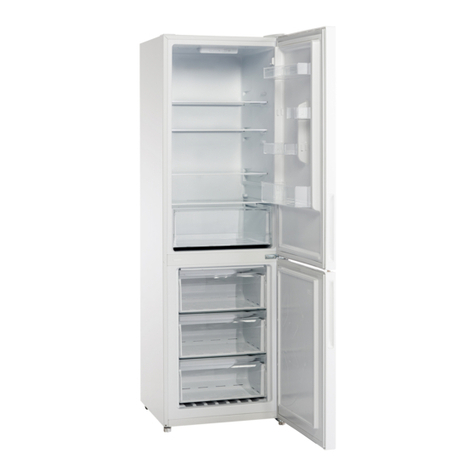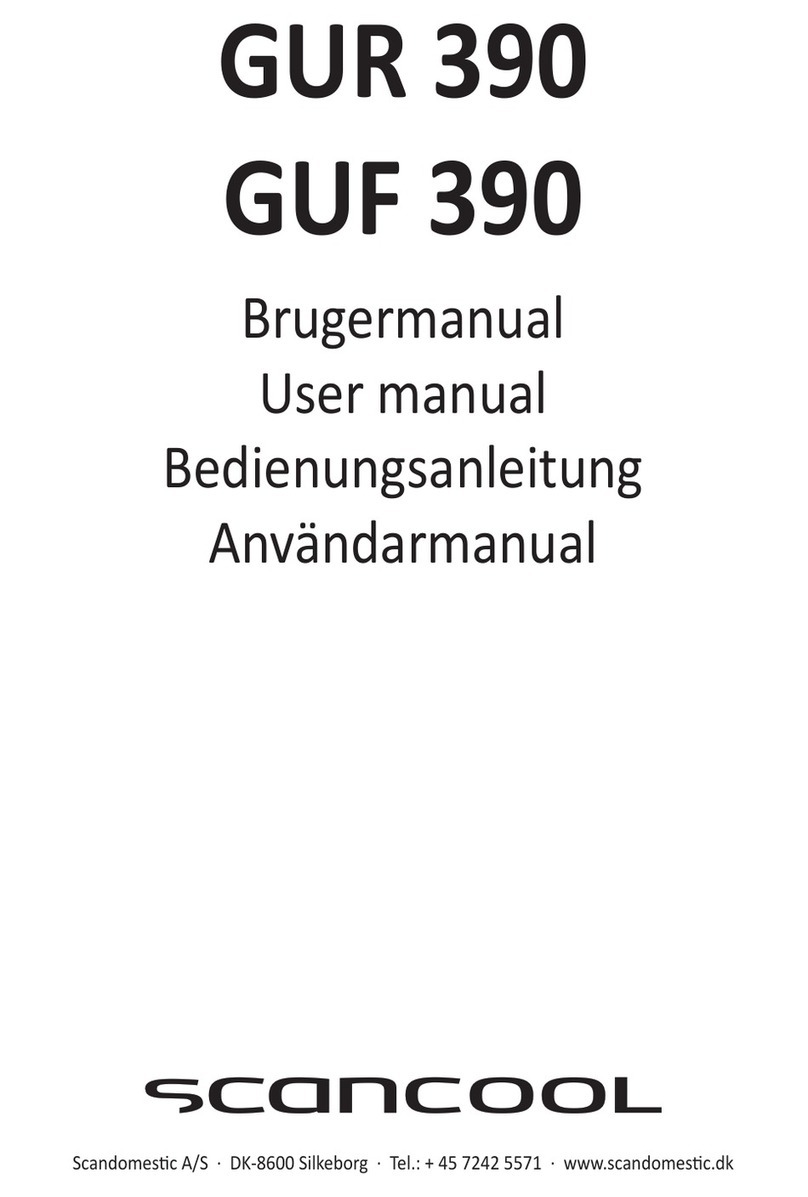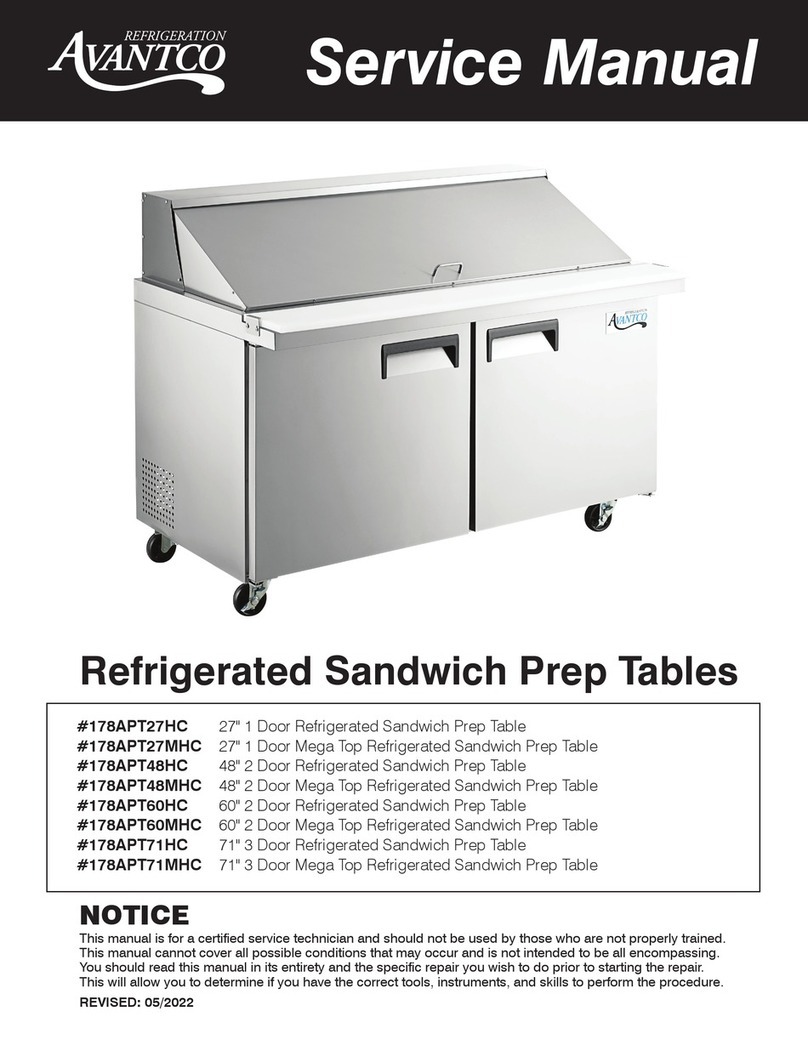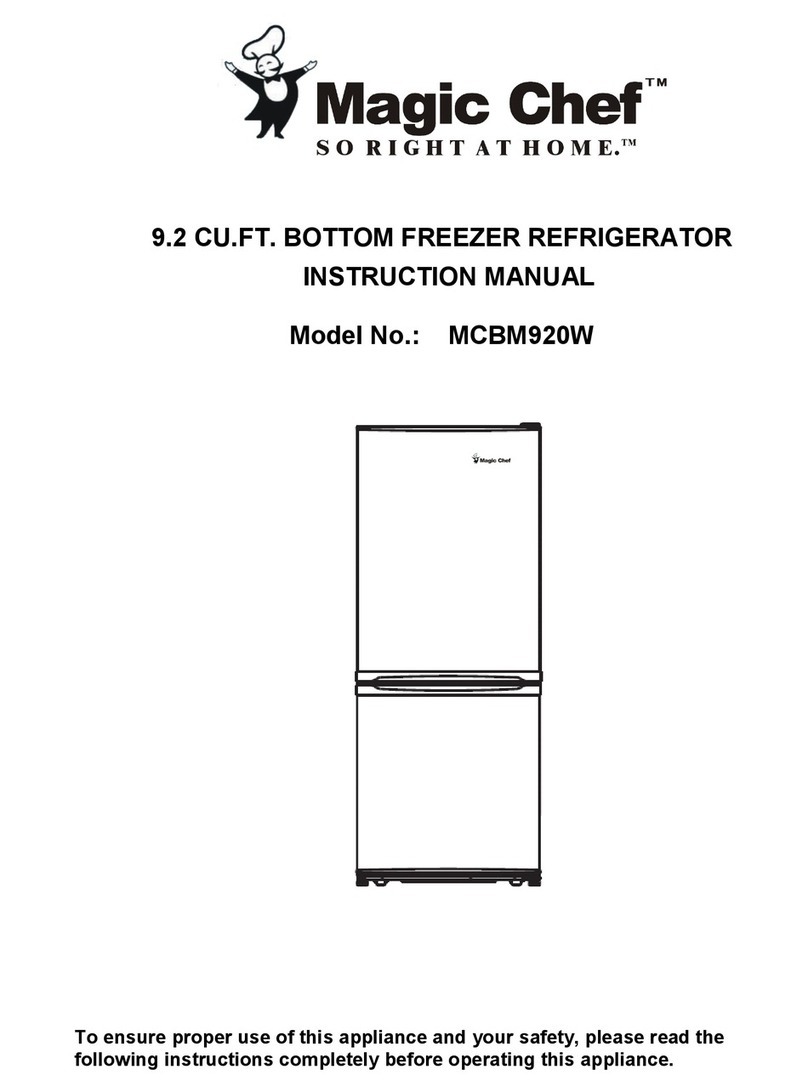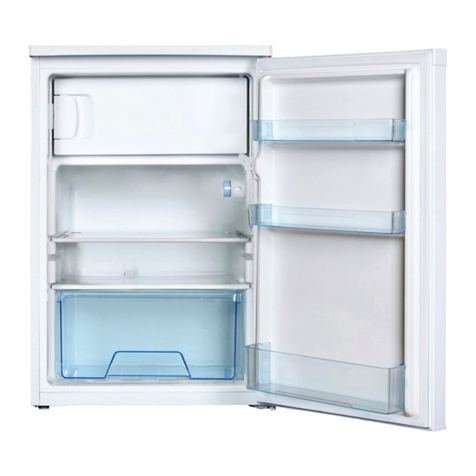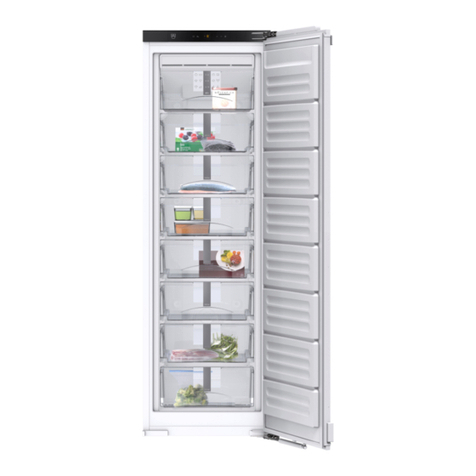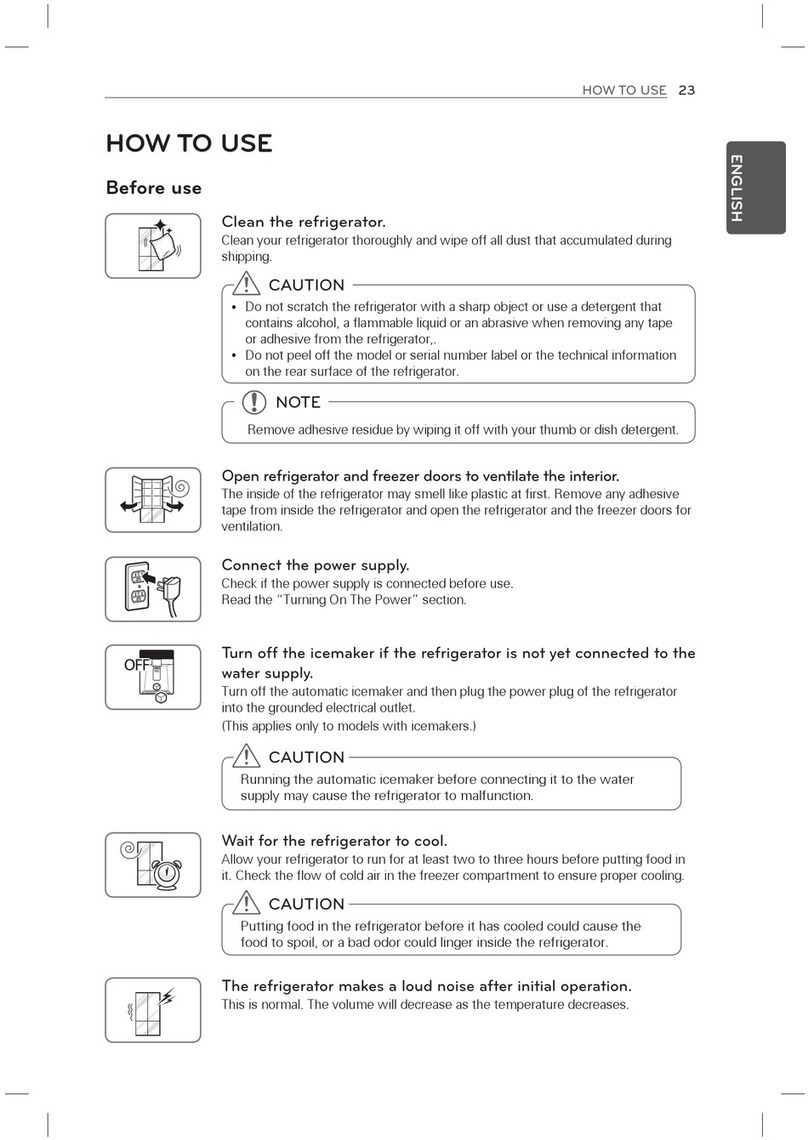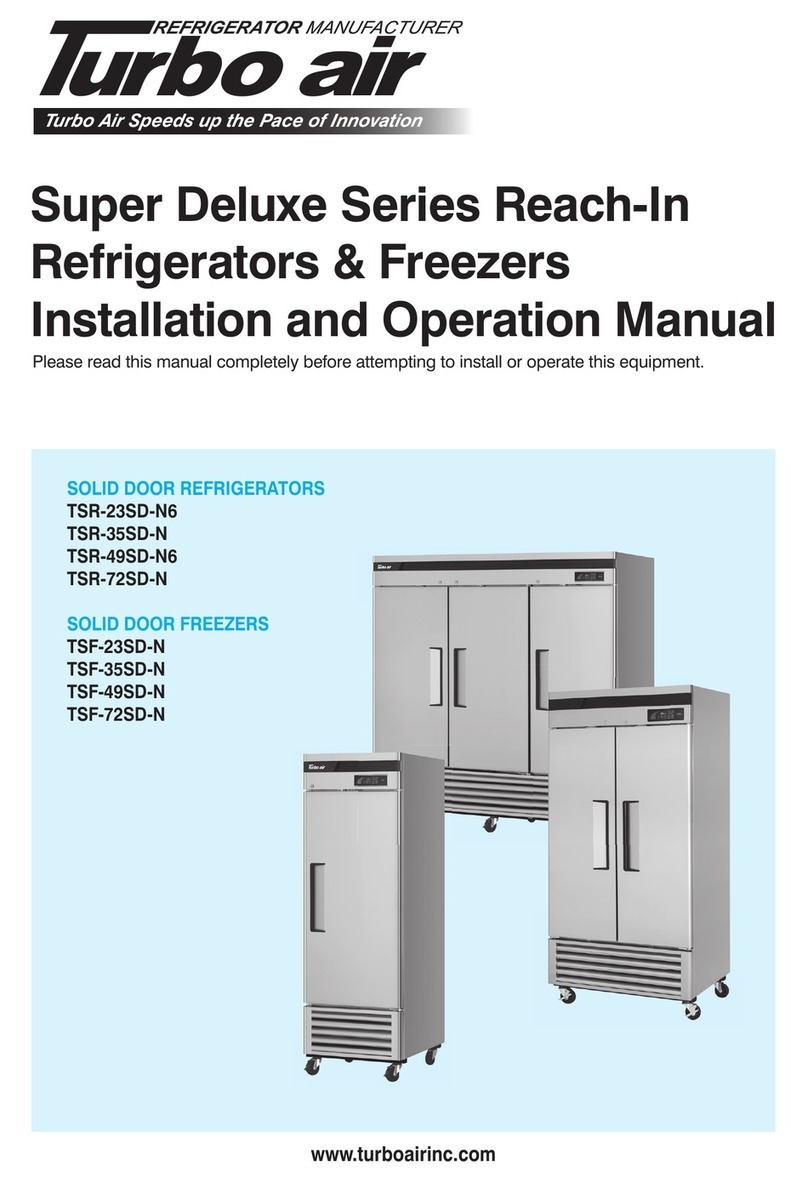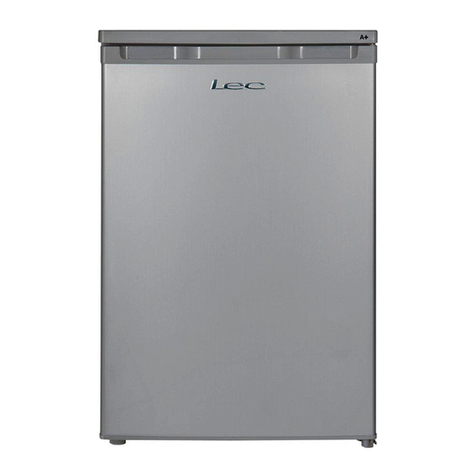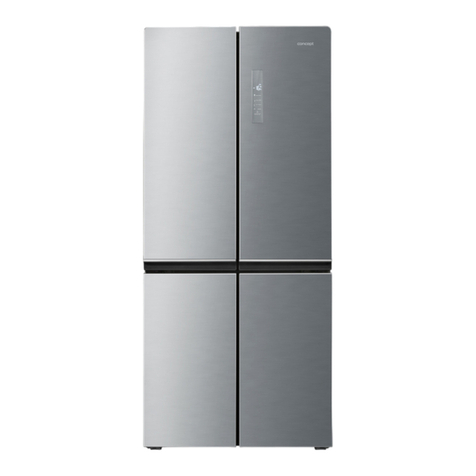Electra BLU106WE User manual

Fridge / User ManualEN
BLU106WE

EN - 2
Thank you for choosing this product.
This user manual contains important information on safety and instructions intended to
assist you in the operation and maintenance of your appliance.
Please take the time to read this user manual before using your appliance and keep this
book for future reference.
Icon Type Meaning
WARNING Serious injury or death risk
RISK OF ELECTRIC SHOCK Dangerous voltage risk
FIRE Warning; Risk of re / ammable materials
CAUTION Injury or property damage risk
IMPORTANT Operating the system correctly

EN - 3
CONTENTS
1 SAFETY INSTRUCTIONS ............................................................................... 4
1.1 General Safety Warnings ...............................................................................................4
1.2 Inallation warnings .......................................................................................................8
1.3 During Usage..................................................................................................................8
2 DESCRIPTION OF THE APPLIANCE.......................................................... 10
2.1 Dimensions...................................................................................................................11
3 USING THE APPLIANCE .............................................................................. 12
3.1 Thermoat Setting .......................................................................................................12
3.2 Temperature Settings Warnings ...................................................................................12
4 FOOD STORAGE........................................................................................... 13
5 CLEANING AND MAINTENANCE................................................................ 14
5.1 Defroing .....................................................................................................................15
6 SHIPMENT AND REPOSITIONING.............................................................. 15
6.1 Transportation and Changing Positioning ....................................................................15
6.2 Repositioning the Door.................................................................................................15
7 BEFORE CALLING AFTER-SALES SERVICE ........................................... 16
8 TIPS FOR SAVING ENERGY........................................................................ 17
9 TECHNICAL DATA......................................................................................... 17
10 INFORMATION FOR TEST INSTITUTES .................................................. 18
11 CUSTOMER CARE AND SERVICE............................................................ 18

EN - 4
1 SAFETY INSTRUCTIONS
1.1 General Safety Warnings
Read this user manual carefully.
WARNING: Keep ventilation openings, in the
appliance enclosure or in the built-in structure, clear of
obstruction.
WARNING: Do not use mechanical devices or
other means to accelerate the defrosting process,
other than those recommended by the manufacturer.
WARNING: Do not use electrical appliances inside
the food storage compartments of the appliance,
unless they are of the type recommended by the
manufacturer.
WARNING: Do not damage the refrigerant circuit.
WARNING: When positioning the appliance,
ensure the supply cord is not trapped or damaged.
WARNING: Do not locate multiple portable socket-
outlets or portable power supplies at the rear of the
appliance.
WARNING: In order to avoid any hazards resulting
from the instability of the appliance, it must be xed in
accordance with the instructions.
If your appliance uses R600a as a refrigerant (this
information will be provided on the label of the cooler)
you should take care during transportation and
installation to prevent the cooler elements from being
damaged. R600a is an environmentally friendly and

EN - 5
natural gas, but it is explosive. In the event of a leak
due to damage of the cooler elements, move your
fridge away from open ames or heat sources and
ventilate the room where the appliance is located for a
few minutes.
• While carrying and positioning the fridge, do not
damage the cooler gas circuit.
• Do not store explosive substances such as aerosol
cans with a ammable propellant in this appliance.
• This appliance is intended to be used in household
and domestic applications such as:
–sta kitchen areas in shops, oces and other
working environments.
–farm houses and by clients in hotels, motels and
other residential type environments.
–bed and breakfast type environments;
–catering and similar non-retail applications.
• If the socket does not match the refrigerator plug,
it must be replaced by the manufacturer, a service
agent or similarly qualied persons in order to avoid
a hazard.
• A specially grounded plug has been connected
to the power cable of your refrigerator. This plug
should be used with a specially grounded socket
of 16 amperes. If there is no such socket in your
house, please have one installed by an authorised
electrician.

EN - 6
• This appliance can be used by children aged from
8 years and above and persons with reduced
physical, sensory or mental capabilities or lack of
experience and knowledge if they have been given
supervision or instruction concerning use of the
appliance in a safe way and understand the hazards
involved. Children shall not play with the appliance.
Cleaning and user maintenance shall not be made
by children without supervision.
• Children aged from 3 to 8 years are allowed to load
and unload refrigerating appliances. Children are not
expected to perform cleaning or user maintenance
of the appliance, very young children (0-3 years old)
are not expected to use appliances, young children
(3-8 years old) are not expected to use appliances
safely unless continuous supervision is given, older
children (8-14 years old) and vulnerable people can
use appliances safely after they have been given
appropriate supervision or instruction concerning
use of the appliance. Very vulnerable people are
not expected to use appliances safely unless
continuous supervision is given.
• If the supply cord is damaged, it must be replaced
by the manufacturer, an authorised service agent or
similar qualied persons, in order to avoid a hazard.
• This appliance is not intended for use at altitudes
exceeding 2000 m.

EN - 7
To avoid contamination of food, please respect the
following instructions:
• Opening the door for long periods can cause
a signicant increase of the temperature in the
compartments of the appliance.
• Clean regularly surfaces that can come in contact
with food and accessible drainage systems
• Store raw meat and sh in suitable containers in the
refrigerator, so that it is not in contact with or drip
onto other food.
• Two-star frozen-food compartments are suitable for
storing pre-frozen food, storing or making ice cream
and making ice cubes.
• One-, two- and three-star compartments are not
suitable for the freezing of fresh food.
• If the refrigerating appliance is left empty for long
periods, switch o, defrost, clean, dry, and leave the
door open to prevent mould developing within the
appliance.

EN - 8
1.2 Installation warnings
Before using your fridge for the rst time,
please pay attention to the following points:
• The operating voltage for your fridge is
220-240 V at 50Hz.
• The plug must be accessible after
installation.
• Your fridge may have an odour when it is
operated for the rst time. This is normal
and the odour will fade when your fridge
starts to cool.
• Before connecting your fridge, ensure
that the information on the data plate
(voltage and connected load) matches
that of the mains electricity supply. If in
doubt, consult a qualied electrician.
• Insert the plug into a socket with an
ecient ground connection. If the socket
has no ground contact or the plug does
not match, we recommend you consult a
qualied electrician for assistance.
• The appliance must be connected
with a properly installed fused socket.
The power supply (AC) and voltage at
the operating point must match with
the details on the name plate of the
appliance (the name plate is located on
the inside left of the appliance).
• We do not accept responsibility for any
damages that occur due to ungrounded
usage.
• Place your fridge where it will not be
exposed to direct sunlight.
• Your fridge must never be used outdoors
or exposed to rain.
• Your appliance must be at least 50 cm
away from stoves, gas ovens and heater
cores, and at least 5 cm away from
electrical ovens.
• If your fridge is placed next to a deep
freezer, there must be at least 2 cm
between them to prevent humidity
forming on the outer surface.
• Do not cover the body or top of fridge
with lace. This will aect the performance
of your fridge.
• Clearance of at least 150 mm is required
at the top of your appliance. Do not place
anything on top of your appliance.
• Do not place heavy items on the
appliance.
• Clean the appliance thoroughly before
use (see Cleaning and Maintenance).
• Before using your fridge, wipe all parts
with a solution of warm water and a
teaspoon of sodium bicarbonate. Then,
rinse with clean water and dry. Return all
parts to the fridge after cleaning.
• Use the adjustable front legs to make
sure your appliance is level and stable.
You can adjust the legs by turning them
in either direction. This must be done
before placing food in the appliance.
• Install the two plastic distance guides (the
parts on the black vanes
-condenser- at the rear)
by turning it 90° (as
shown in the gure) to
prevent the condenser
from touching the wall.
• The distance between
the appliance and back wall must be a
maximum of 75 mm.
1.3 During Usage
• Do not connect your fridge to the mains
electricity supply using an extension lead.
• Do not use damaged, torn or old plugs.
• Do not pull, bend or damage the cord.
• Do not use plug adapter.
• This appliance is designed for use by
adults. Do not allow children to play with
the appliance or hang o the door.
• Never touch the power cord/plug with wet
hands. This may cause a short circuit or
electric shock.
• Do not place explosive or ammable
material in your fridge. Place drinks with
high alcohol content vertically in the
fridge compartment and make sure their
tops are tightly closed.

EN - 9
Old and Out-of-order Fridges
• If your old fridge or freezer has a
lock, break or remove the lock before
discarding it, because children may
get trapped inside it and may cause an
accident.
• Old fridges and freezers contain
isolation material and refrigerant with
CFC. Therefore, take care not to harm
environment when you are discarding
your old fridges.
CE Declaration of conformity
We declare that our products meet the
applicable European Directives, Decisions
and Regulations and the requirements
listed in the standards referenced.
Disposal of your old appliance
The symbol on the product or on
its packaging indicates that this
product may not be treated as
household waste. Instead it shall
be handed over to the applicable
collection point for the recycling of electrical
and electronic equipment. By ensuring
this product is disposed of correctly,
you will help prevent potential negative
consequences for the environment and
human health, which could otherwise be
caused by inappropriate waste handling
of this product. For more detailed
information about recycling of this product,
please contact your local city oce, your
household waste disposal service or the
shop where you purchased the product.
Packaging and the Environment
Packaging materials protect
your machine from damage that
may occur during transportation.
The packaging materials are
environmentally friendly as they are
recyclable. The use of recycled material
reduces raw material consumption and
therefore decreases waste production.
Notes:
• Please read the instruction manual
carefully before installing and using your
appliance. We are not responsible for the
damage occurred due to misuse.
• Follow all instructions on your appliance
and instruction manual, and keep this
manual in a safe place to resolve the
problems that may occur in the future.
• This appliance is produced to be used
in homes and it can only be used in
domestic environments and for the
specied purposes. It is not suitable for
commercial or common use. Such use
will cause the guarantee of the appliance
to be cancelled and our company will not
be responsible for any losses incurred.
• This appliance is produced to be used
in houses and it is only suitable for
cooling / storing foods. It is not suitable
for commercial or common use and/or
for storing substances except for food.
Our company is not responsible for any
losses incurred by inappropriate usage of
the appliance.

EN - 10
2 DESCRIPTION OF THE
APPLIANCE
This appliance is not intended to be used
as a built-in appliance.
8
1
2
3
4
5
6
7
This presentation is only for
information about the parts of the
appliance. Parts may vary according to the
appliance model.
1) Thermostat box
2) Refrigerator shelves
3) Crisper cover
4) Crisper
5) Levelling feet
6) Bottle shelf
7) Door shelves
8) Egg holder
General notes:
Fresh Food Compartment (Fridge): Most
ecient use of energy is ensured in the
conguration with the drawers in the bottom
part of the appliance, and shelves evenly
distributed, position of door bins does not
aect energy consumption.

EN - 11
2.1 Dimensions
H1
H2
Space required in use 2
H2 mm 988
W2 mm 640
D2 mm 692
Overall space required in use 3
W3 mm 658
D3 mm 1134,5
Overall dimensions 1
H1 mm 838
W1 mm 540
D1 mm 595
W1
D1
W2
D2
W3
D3

EN - 12
3 USING THE APPLIANCE
3.1 Thermostat Setting
The fridge thermostat automatically
regulates the temperature of the
compartment. Fridge temperatures can
be obtained by rotating the knob to higher
numbers, 1 to 5.
Important note: Do not try to rotate
the knob beyond position 1, it will stop
your appliance from working.
Thermostat knob
Lamp cover
Thermostat Settings
• Set the knob to a low/medium position,
up to 3, for short-term storage of food in
the appliance.
• Set the knob to a medium position, 3 or
4, for long-term storage of food in the
appliance.
• For long-term storage of food in the
refrigerator, you can set knop maximum
position (4 - 5).
Larders (coolers) have not any freezer
compartment but can cool up to
4 - 6 °C.
3.2 Temperature Settings Warnings
• The ambient temperature, temperature of
the freshly stored food and how often the
door is opened aects the temperature
in the fridge. If required, change the
temperature setting.
• It is not recommended that you operate
your fridge in environments colder than
10°C in terms of its eciency.
• When setting the thermostat, take into
consideration how often the appliance
door is opened and closed, how much
food is stored in the refrigerator, and the
environment in which the refrigerator is
located.
• When the appliance is rst switched on,
allow it to run for 24 hours in order to
reach operating temperature. During this
time, do not open the door and do not
keep a large quantity of food inside.
• Unplug your appliance during a power cut
to prevent damage to the compressor.
Once power is restored, delay plugging
in your appliance for 5 to 10 minutes.
This will help prevent damage to the
appliance's components.
• Your appliance is designed to operate in
the ambient temperature ranges stated
in the standards, according to the climate
class stated in the information label. It
is not recommended that your fridge is
operated in the environments which are
outside of the stated temperature ranges.
This will reduce the cooling eciency of
the appliance.
• Your appliance is designed to operate in
the ambient temperature (T/SN = 10°C
- 43°C) intervals stated in the standards,
according to the climate class displayed
on the information label. We do not
recommend operating your appliance out
of the stated temperature limits in terms
of cooling eectiveness.
Climate class and meaning:
T (tropical): This refrigerating appliance
is intended to be used at ambient
temperatures ranging from 16 °C to 43 °C.
ST (subtropical): This refrigerating
appliance is intended to be used at ambient
temperatures ranging from 16 °C to 38 °C.
N (temperate): This refrigerating appliance
is intended to be used at ambient
temperatures ranging from 16 °C to 32 °C.
SN (extended temperate): This
refrigerating appliance is intended to be
used at ambient temperatures ranging from
10 °C to 32 °C.

EN - 13
4 FOOD STORAGE
• To reduce humidity and avoid the
consequent formation of frost, always
store liquids in sealed containers in the
refrigerator. Frost tends to concentrate in
the coldest parts of the evaporating liquid
and, in time, your appliance will require
more frequent defrosting.
• Never place warm food in the
refrigerator. Warm food should be
allowed to cool at room temperature
and should be arranged to ensure
adequate air circulation in the refrigerator
compartment.
• Make sure no items are in direct contact
with the rear wall of the appliance as
frost will develop and packaging will stick
to it. Do not open the refrigerator door
frequently.
• We recommend that meat and clean sh
are loosely wrapped and stored on the
glass shelf just above the vegetable bin
where the air is cooler, as this provides
the best storage conditions.
• Store loose fruit and vegetable items in
the crisper containers.
• Store loose fruit and vegetables in the
crisper.
• Storing fruit and vegetables separately
helps prevent ethylene-sensitive
vegetables (green leaves, broccoli,
carrot, etc.) being aected by ethylene-
releaser fruits (banana, peach, apricot,
g etc.).
• Do not put wet vegetables into the
refrigerator.
• Storage time for all food products
depends on the initial quality of the food
and an uninterrupted refrigeration cycle
before refrigerator storage.
• To avoid cross-contamination do not
store meat products with fruit and
vegetables. Water leaking from meat
may contaminate other products in the
refrigerator. You should package meat
products and clean any leakages on the
shelves.
• Do not put food in front of the air ow
passage.
• Consume packaged foods before the
recommended expiry date.
NOTE: Potatoes, onions and garlic
should not be stored in the refrigerator.
• For normal working conditions, it will
be sucient to adjust the temperature
setting of your refrigerator to +4 °C.
• The temperature of the fridge
compartment should be in the range
of 0-8 °C, fresh foods below 0 °C are
iced and rotted, bacterial load increases
above 8 °C, and spoils.
• Do not put hot food in the refrigerator
immediately, wait for the temperature
to pass outside. Hot foods increase the
degree of your refrigerator and cause
food poisoning and unnecessary spoiling
of the food.
• Meat, sh, etc. should be store in the
chiller compartment of the food, and the
vegetable compartment is preferred for
vegetables. (if available)
• To prevent cross contamination, meat
products and fruit vegetables are not
stored together.
• Foods should be placed in the refrigerator
in closed containers or covered to
prevent moisture and odors.

EN - 14
The table below is a quick guide to show
you the most ecient way to store the
major food groups in your refrigerator
compartment.
Food Maximum
storage time
How and where to
store
Vegetables
and fruits 1 week Vegetable bin
Meat and
sh 2 - 3 days
Wrap in plastic foil,
bags, or in a meat
container and store
on the glass shelf
Fresh
cheese 3 - 4 days On the designated
door shelf
Butter and
margarine 1 week On the designated
door shelf
Bottled
products
e.g. milk
and
yoghurt
Until the
expiry date
recommended
by the
producer
On the designated
door shelf
Eggs 1 month On the designated
egg shelf
Cooked
food 2 days All shelves
5 CLEANING AND
MAINTENANCE
Disconnect the unit from the power
supply before cleaning.
Do not wash your appliance by
pouring water on it.
Do not use abrasive products,
detergents or soaps for cleaning the
appliance. After washing, rinse with clean
water and dry carefully. When you have
nished cleaning, reconnect the plug to the
mains supply with dry hands.
• Make sure that no water enters the lamp
housing and other electrical components.
• The appliance should be cleaned
regularly using a solution of bicarbonate
of soda and lukewarm water.
• Clean the accessories separately by
hand with soap and water. Do not wash
accessories in a dish washer.
• Clean the condenser with a brush at least
twice a year. This will help you to save on
energy costs and increase productivity.
The power supply must be
disconnected during cleaning.

EN - 15
5.1 Defrosting
Defrosting the Refrigerator
Compartment
• Defrosting occurs automatically in
the refrigerator compartment during
operation. The water is collected by
the evaporation tray and evaporates
automatically.
• The evaporation tray and the water drain
hole should be cleaned periodically with
the defrost drain plug to prevent the
water from collecting at the bottom of the
refrigerator instead of owing out.
• You can also clean the drain hole by
pouring half a glass of water down it.
Replacing LED Lighting
If your appliance has LED lighting
contact the help desk as this should
be changed by authorized personnel only.
6 SHIPMENT AND
REPOSITIONING
6.1 Transportation and Changing
Positioning
• The original packaging and foam may be
kept for re-transportation (optional).
• Fasten your appliance with thick
packaging, bands or strong cords and
follow the instructions for transportation
on the packaging.
• Remove all movable parts (shelves,
accessories, vegetable bins, and so on)
or x them into the appliance against
shocks using bands when re-positioning
or transporting.
Always carry your appliance in the
upright position.
6.2 Repositioning the Door
• It is not possible to change the opening
direction of your appliance door if door
handles are installed on the front surface
of the appliance door.
• It is possible to change the opening
direction of the door on models without
handles.
• If the door-opening direction of your
appliance can be changed, contact the
nearest Authorised Service Centre to
change the opening direction.

EN - 16
7 BEFORE CALLING AFTER-
SALES SERVICE
Your fridge is not operating
Check if:
• There is power
• The plug is correctly connected to the
socket
• The plug or mains fuse has blown
• The socket is faulty. Examine this by
plugging your fridge into a working
socket.
The appliance performs poorly
Check if:
• The appliance is overloaded
• The doors are closed properly
• There is any dust on the condenser
• There is enough space near the rear and
side walls.
Your fridge is operating noisily
Motor noise: Indicates the compressor
is operating normally. The compressor
may cause more noise for a short time
when it is rst activated.
Bubbling noise and splash: Due to
the ow of the refrigerant in the tubes of
the system.
Air blowing noise: Indicates normal
operation of the system due to the
circulation of air.
There is a build-up of humidity inside
the cooler
Check if:
• All food is packed properly. Containers
must be dry before being placed in the
fridge.
• The fridge door is opened frequently.
Humidity of the room enters the fridge
when the doors are opened. Humidity
increases faster when the doors are
opened more frequently, especially if the
humidity of the room is high.
The door is not opening and closing
properly
Check if:
• There is food or packaging preventing the
door from closing
• The door compartments, shelves and
drawers are placed properly
• The door joints are broken or torn
• Your fridge is level.
Recommendations
• If the appliance is switched o or
unplugged, wait at least 5 minutes before
plugging the appliance in or restarting
it in order to prevent damage to the
compressor.
• If you will not use your fridge for a long
time (e.g. in summer holidays) unplug it.
Clean your fridge according to chapter
cleaning and leave the door open to
prevent humidity and smell.
• If a problem persists after you have
followed all the above instructions,
please consult the nearest authorised
service centre.
• The appliance you have purchased is
designed for domestic use only. It is not
suitable for commercial or common use.
If the consumer uses the appliance in a
way that does not comply with this, we
emphasise that the manufacturer and
the dealer will not be responsible for any
repair and failure within the guarantee
period.

EN - 17
8 TIPS FOR SAVING ENERGY
1. Install the appliance in a cool, well-
ventilated room, but not in direct sunlight
and not near a heat source (such as a
radiator or oven) otherwise an insulating
plate should be used.
2. Allow warm food and drinks to cool
before placing them inside the appliance.
3. Drinks or other liquids should be
covered when inside the appliance. If
left uncovered, the humidity inside the
appliance will increase, therefore the
appliance uses more energy. Keeping
drinks and other liquids covered helps
preserve their smell and taste.
4. Avoid keeping the doors open for long
periods and opening the doors too
frequently as warm air will enter the
appliance and cause the compressor to
switch on unnecessarily often.
5. Keep the covers of the dierent
temperature compartments ( such as the
crisper and chiller) closed.
6. The door gasket must be clean and
pliable. In case of wear, replace the
gasket.
9 TECHNICAL DATA
The technical information is situated in
the rating plate on the internal side of the
appliance and on the energy label.
The QR code on the energy label supplied
with the appliance provides a web link to
the information related to the performance
of the appliance in the EU EPREL
database.
Keep the energy label for reference
together with the user manual and all other
documents provided with this appliance.
It is also possible to nd the same
information in EPREL using the link https://
eprel.ec.europa.eu and the model name
and product number that you nd on the
rating plate of the appliance.
See the link www.theenergylabel.eu for
detailed information about the energy label.

EN - 18
10 INFORMATION FOR TEST
INSTITUTES
Appliance for any EcoDesign verication
shall be compliant with EN 62552.
Ventilation requirements, recess
dimensions and minimum rear clearances
shall be as stated in this User Manual at
Chapter 2. Please contact the manufacturer
for any other further information, including
loading plans.
11 CUSTOMER CARE AND
SERVICE
Always use original spare parts.
When contacting our Authorised Service
Centre, ensure that you have the following
data available: Model, Serial Number and
Service Index.
The information can be found on the rating
plate. You can nd the rating label inside
the fridge zone on the left lower side.
The original spare parts for some specic
components are available for a minimum
of 7 or 10 years, based on the type of
component, from the placing on the market
of the last unit of the model.
Visit our website to:
http://vestel.co.uk/en/

EN - 19

52343180
Table of contents
Other Electra Refrigerator manuals
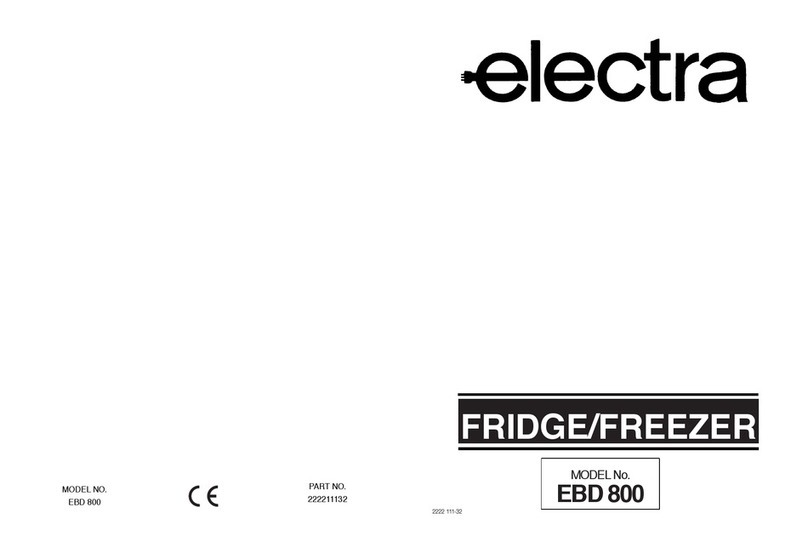
Electra
Electra EBD800 User manual

Electra
Electra EFUL48SE User manual

Electra
Electra ER-95DF User manual
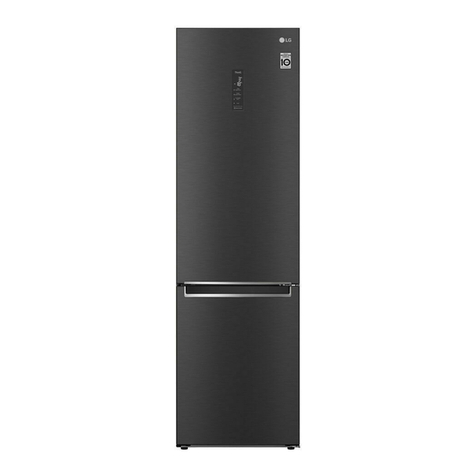
Electra
Electra ELC 13 User manual
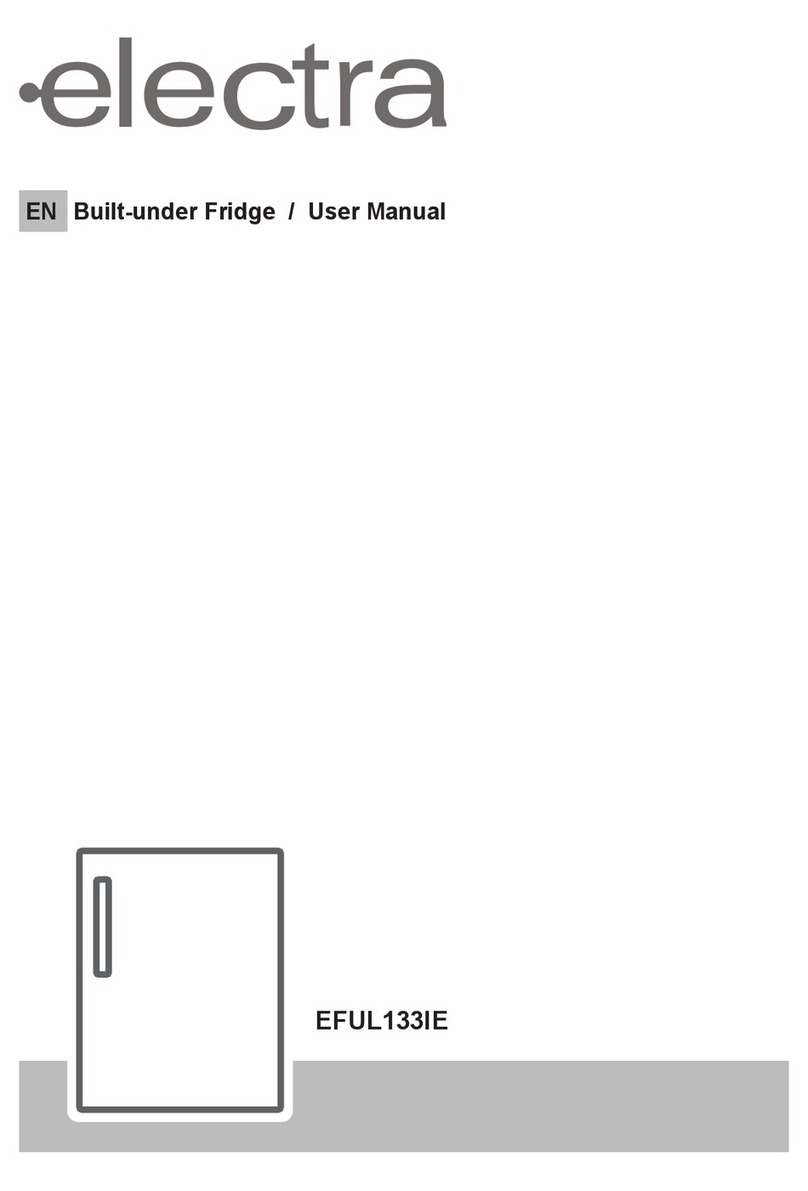
Electra
Electra EFUL133IE User manual
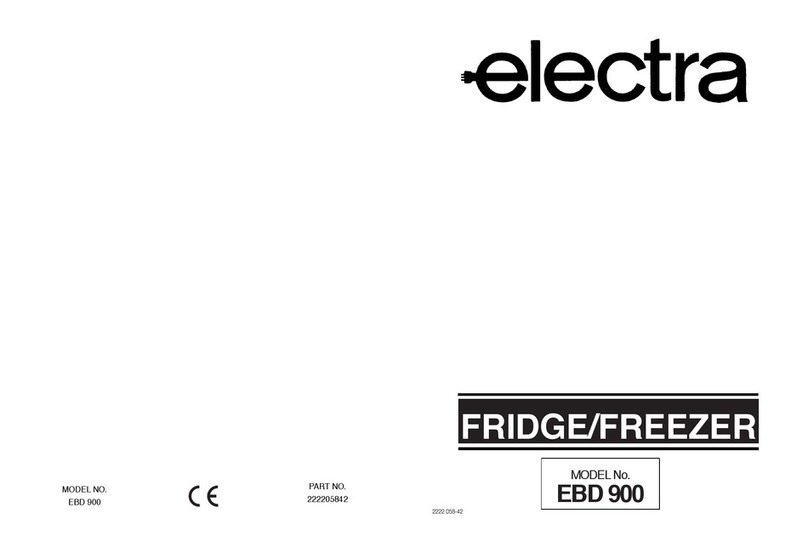
Electra
Electra EBD900 User manual
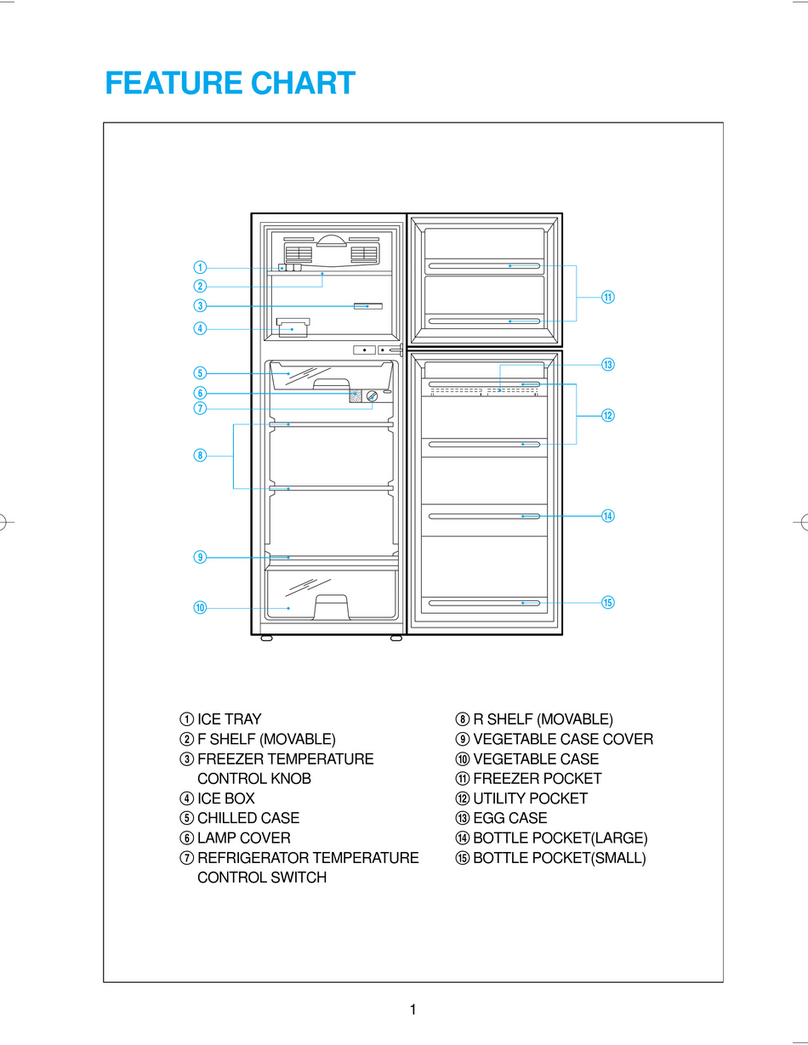
Electra
Electra ER-280NF User manual
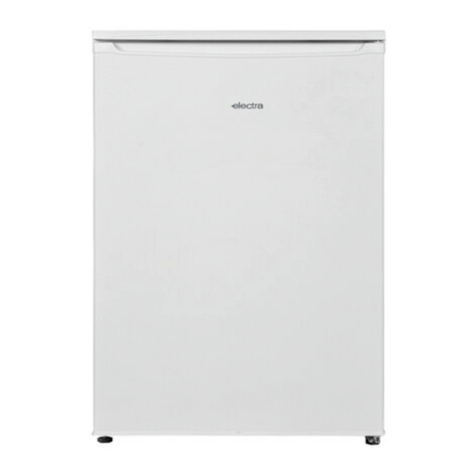
Electra
Electra BLU106W User manual
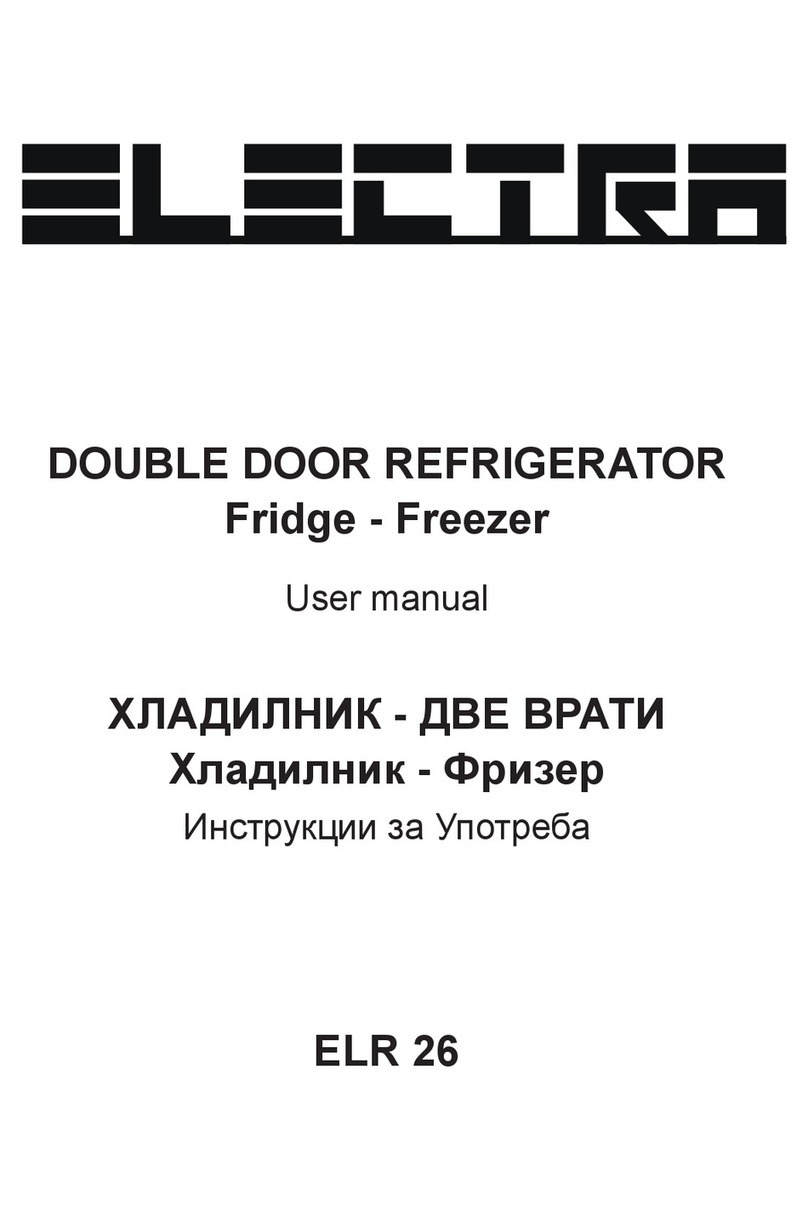
Electra
Electra ELR 26 User manual
Popular Refrigerator manuals by other brands

Concept2
Concept2 LA7991bc manual
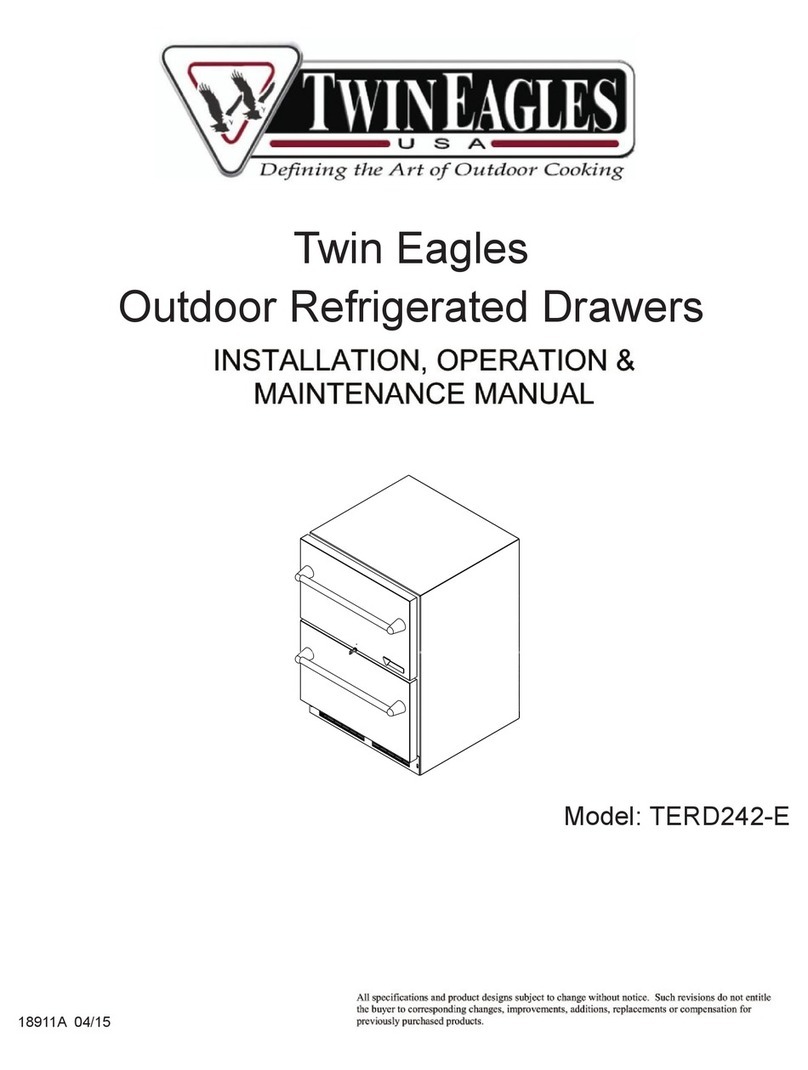
Twin Eagles
Twin Eagles TERD242-E Installation, operation & maintanance manual
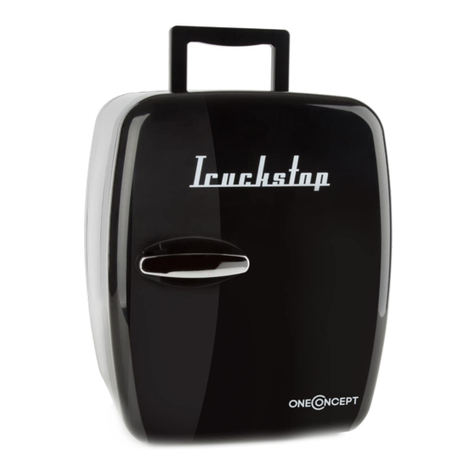
oneConcept
oneConcept Truckstop 10030580 manual
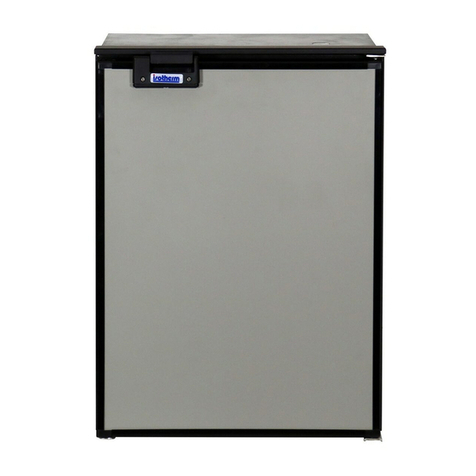
Isotherm
Isotherm CR 130 Installation & operating instructions
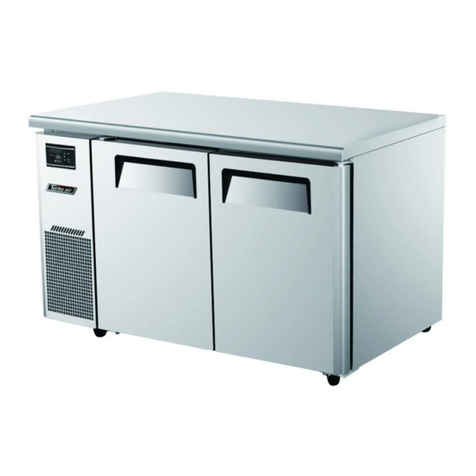
Turboair
Turboair KUR9-1 Service manual
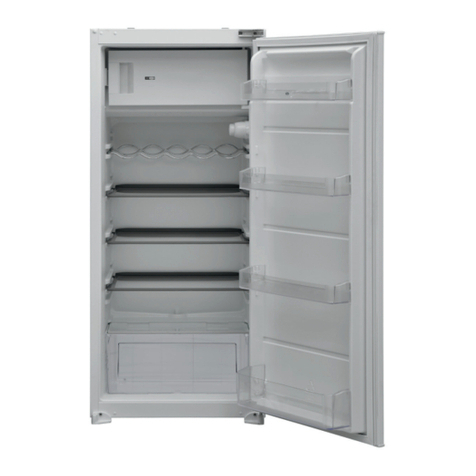
essentiel b
essentiel b ERFI 125-55b1 user guide
